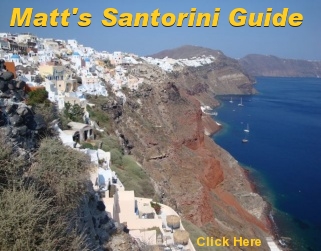|
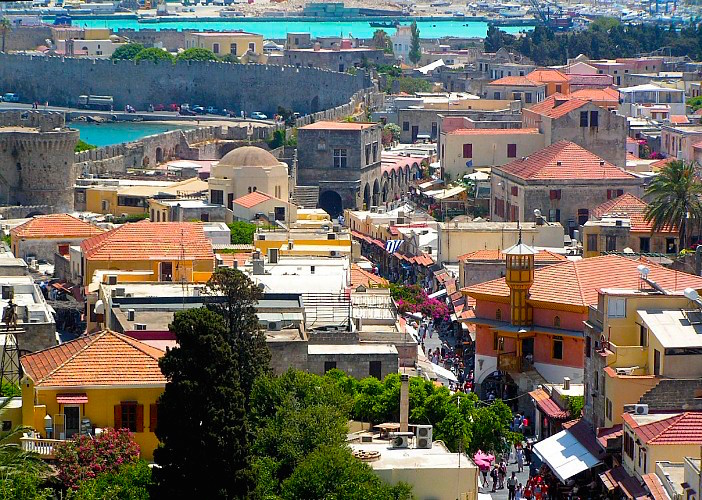 The Old City of Rhodes
with a current population of 6,000 inhabitants
is surrounded by medieval walls with seven
gates: Gate of the Naval
Station, Gate of Agios
Ioannis, Gate of Agia
Ekaterini, Gate of the
Apostle Paul, Gate of Amboise, Gate of Agios
Athanassios and the Gate of the Port. To enter any of these gates is to enter another world. Now it happens to be a world of tourist shops, restaurants, cafes and museums, more like a Turkish bazaar than any Greek city, but anyone with imagination can't help but be touched by the history of the place where a handful of Knights were the last Christian holdouts in a part of the world that had
become completely dominated by Muslims, in particular the Ottoman Turks. The Old City of Rhodes
with a current population of 6,000 inhabitants
is surrounded by medieval walls with seven
gates: Gate of the Naval
Station, Gate of Agios
Ioannis, Gate of Agia
Ekaterini, Gate of the
Apostle Paul, Gate of Amboise, Gate of Agios
Athanassios and the Gate of the Port. To enter any of these gates is to enter another world. Now it happens to be a world of tourist shops, restaurants, cafes and museums, more like a Turkish bazaar than any Greek city, but anyone with imagination can't help but be touched by the history of the place where a handful of Knights were the last Christian holdouts in a part of the world that had
become completely dominated by Muslims, in particular the Ottoman Turks.
|
|
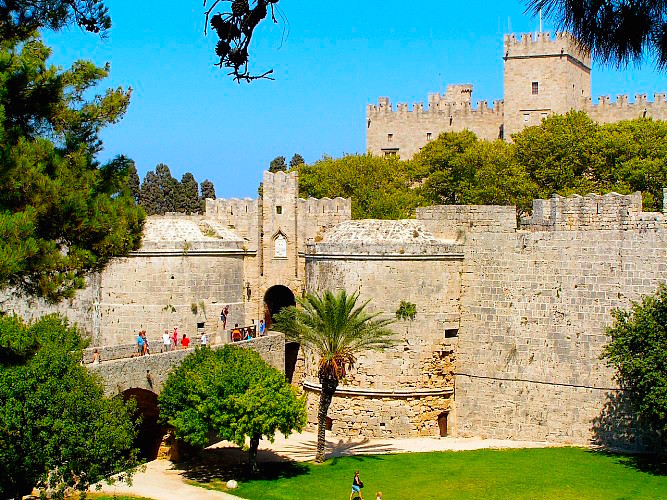 When the city finally did fall after a siege that exhausted both defenders and besiegers the remaining Knights were offered safe passage and on January 1st of 1523 left Rhodes along with 5000 of the Christian inhabitants of the island who chose to leave rather than live under the Sultan. In the defense of the city 2000
Christians had died. The Turks had lost 50,000 trying to take it. This is not, however just an old town
filled with ghosts of the past. The old city of Rhodes is a living, vibrant community with many homes and business, not all of them connected to tourism. When the city finally did fall after a siege that exhausted both defenders and besiegers the remaining Knights were offered safe passage and on January 1st of 1523 left Rhodes along with 5000 of the Christian inhabitants of the island who chose to leave rather than live under the Sultan. In the defense of the city 2000
Christians had died. The Turks had lost 50,000 trying to take it. This is not, however just an old town
filled with ghosts of the past. The old city of Rhodes is a living, vibrant community with many homes and business, not all of them connected to tourism.
The
Medieval City was divided into three
parts: the northern part included the
Acropolis of the Knights and the
Palace of the Grand Master while
the southern part include Hora, were
the commoners lived. The Jewish Quarter is the third section and the least developed commercially in terms of tourism and is mostly residential, though the Hora is also residential mixed with bars, restaurants, cafes and shops.
|
|
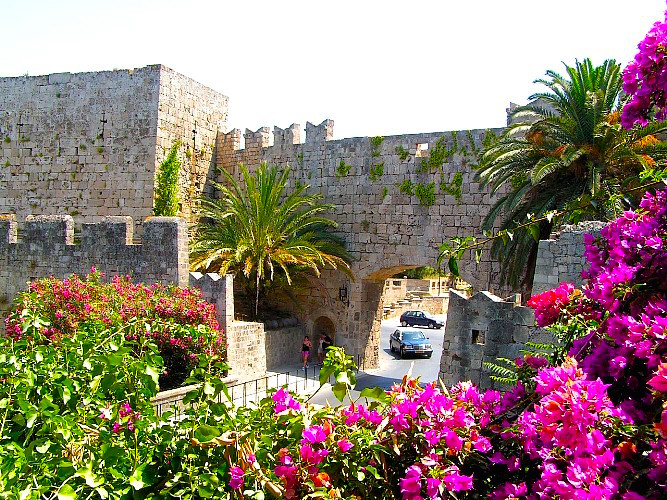 As you enter the city either from the commercial harbor through the Gate of Navarhou or from the new town through the gate of Eleftherias you see the remains of the 3rd century temple of Aphrodite, and behind it is the
Lodge of the Knights of Aiberne,
built in 1507. Today the
building houses the governor's office.
Next to it is the Lodge of the
Battalion of England and the
first hospital of the Knights,
which was built by the Grandmaster
in 1440, which today is the Library of the Archaeological Society. The 'New' Hospital
houses the town's Archaeological
Museum which is impressive not only because of the large number of relics but because the building itself is so monumental and has been the Archaeological museum since 1916. Don't miss the beautiful Aphrodite of Rhodes (like I did) which is contained in a small room that I somehow didn't see. The problem with the old city is that after awhile you have seen so many antiquities that your mind goes numb and you wander around like you are in a daze. For that reason I suggest not trying to see it all at once
and to plan your trip so you spend a little extra time in Rhodes than you would on an island with less to offer. As you enter the city either from the commercial harbor through the Gate of Navarhou or from the new town through the gate of Eleftherias you see the remains of the 3rd century temple of Aphrodite, and behind it is the
Lodge of the Knights of Aiberne,
built in 1507. Today the
building houses the governor's office.
Next to it is the Lodge of the
Battalion of England and the
first hospital of the Knights,
which was built by the Grandmaster
in 1440, which today is the Library of the Archaeological Society. The 'New' Hospital
houses the town's Archaeological
Museum which is impressive not only because of the large number of relics but because the building itself is so monumental and has been the Archaeological museum since 1916. Don't miss the beautiful Aphrodite of Rhodes (like I did) which is contained in a small room that I somehow didn't see. The problem with the old city is that after awhile you have seen so many antiquities that your mind goes numb and you wander around like you are in a daze. For that reason I suggest not trying to see it all at once
and to plan your trip so you spend a little extra time in Rhodes than you would on an island with less to offer.
|
|
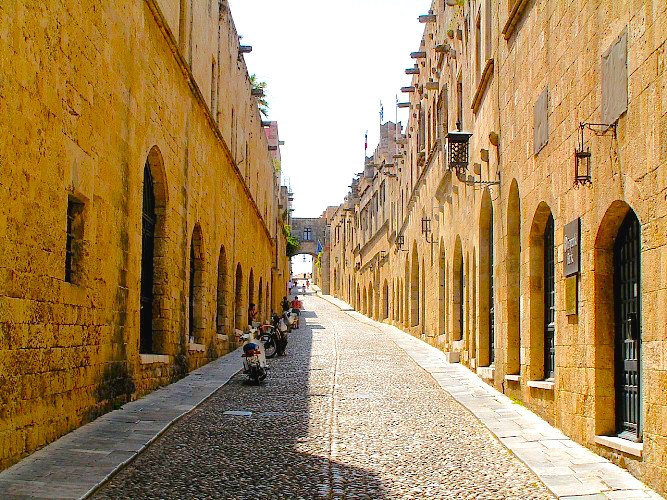 The most beautiful and
interesting part of the Old City for me
is the street of Knights, the most important street of the medieval town. The street is completely restored or preserved
beautifully, and is lined by the
buildings where the holy warriors spent their time in prayer or military practice though it is hard to imagine this going on simultaneously unless you have ever visited the West Campus residence halls of Duke University.
The Street of the Knights
stretches from the New Hospital-Archaeological Museum to the
Grandmaster's Palace where
the Lodge of the Battalion of France,
one of the most beautiful buildings on
the island, stands. Next to it stands
the chapel of the same name with the beautiful statue of
Virgin Mary and the holy infant. The
nearby church of Agios Dimitrios is
built upon the ruins of the ancient
temple of Dionysus. The most beautiful and
interesting part of the Old City for me
is the street of Knights, the most important street of the medieval town. The street is completely restored or preserved
beautifully, and is lined by the
buildings where the holy warriors spent their time in prayer or military practice though it is hard to imagine this going on simultaneously unless you have ever visited the West Campus residence halls of Duke University.
The Street of the Knights
stretches from the New Hospital-Archaeological Museum to the
Grandmaster's Palace where
the Lodge of the Battalion of France,
one of the most beautiful buildings on
the island, stands. Next to it stands
the chapel of the same name with the beautiful statue of
Virgin Mary and the holy infant. The
nearby church of Agios Dimitrios is
built upon the ruins of the ancient
temple of Dionysus.
|
|
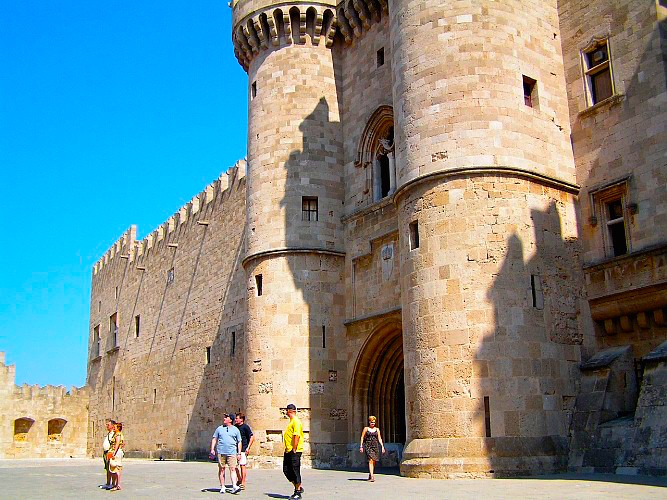 The Palace of the Grandmaster is the single most impressive site in Rhodes if not all of the Dodekanese Islands and the interior is no less awe-inspiring than the formidable outer walls. Within the enormous castle are relics from the medieval period as well as ancient sculptures and
beautiful
1st century floor mosaics which were
brought to Rhodes from the island of Kos. For the people of Kos I would be surprised if this is not their version of the Elgin Marbles and as that island's fortunes fall there may be a movement for their return. A walk through the castle will take about an hour and will bring you through several thousand years of history. There is a medieval snack bar that makes decent coffee and has pastries and sandwiches which is a good meeting place for people who go through museums at different speeds.
(I was there for an hour before my wife showed up). The Palace of the Grandmaster is the single most impressive site in Rhodes if not all of the Dodekanese Islands and the interior is no less awe-inspiring than the formidable outer walls. Within the enormous castle are relics from the medieval period as well as ancient sculptures and
beautiful
1st century floor mosaics which were
brought to Rhodes from the island of Kos. For the people of Kos I would be surprised if this is not their version of the Elgin Marbles and as that island's fortunes fall there may be a movement for their return. A walk through the castle will take about an hour and will bring you through several thousand years of history. There is a medieval snack bar that makes decent coffee and has pastries and sandwiches which is a good meeting place for people who go through museums at different speeds.
(I was there for an hour before my wife showed up).
|
|
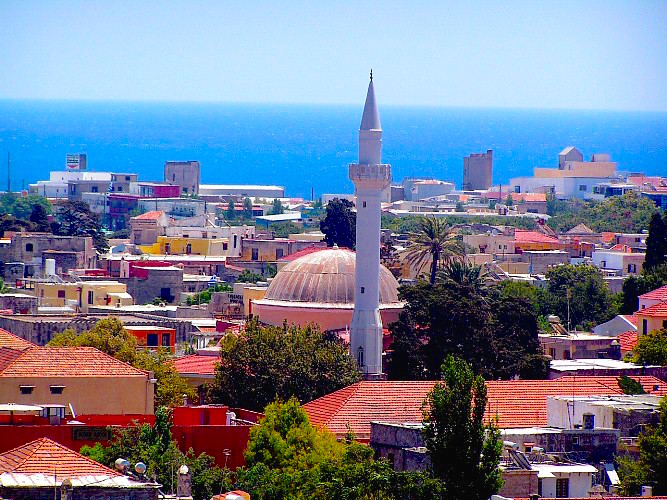 If you want a birds-eye view of the city go to the clock tower where for 4 euros you can climb to the top and trade in your ticket for a drink at the bar when you come down. This building, like many of the buildings in the Old Town is owned by a Turk and the Greek who rents it financed the restoration himself. Rhodes,
which was not a part of Greece when the exchange of population between Greeks and Turks took place after the Asia Minor Disaster and fall
of Smyrna in 1922 (It became part of Greece in 1948 after having been Italian since it's capture in 1912. Because of this there are many Turkish people living in the old city, though they are considered Greeks of the Muslim Faith rather than Turks. In fact the population exchange was done by religion and not ethnicity so there are also Greeks in Turkey because at the time of the exchange they were Muslim. If you want a birds-eye view of the city go to the clock tower where for 4 euros you can climb to the top and trade in your ticket for a drink at the bar when you come down. This building, like many of the buildings in the Old Town is owned by a Turk and the Greek who rents it financed the restoration himself. Rhodes,
which was not a part of Greece when the exchange of population between Greeks and Turks took place after the Asia Minor Disaster and fall
of Smyrna in 1922 (It became part of Greece in 1948 after having been Italian since it's capture in 1912. Because of this there are many Turkish people living in the old city, though they are considered Greeks of the Muslim Faith rather than Turks. In fact the population exchange was done by religion and not ethnicity so there are also Greeks in Turkey because at the time of the exchange they were Muslim.
|
|
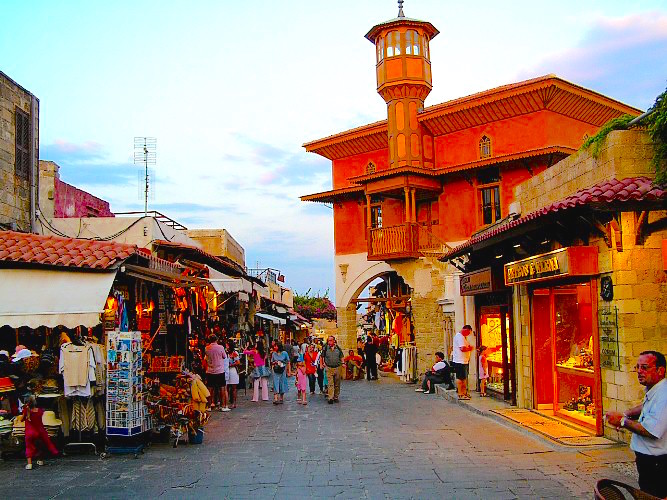 Orffeos Street is a wide road with tourist shops and restaurants near the Gate of Saint Anthony, the Grand Master Palace and the Suleiman Mosque which connects with Socratous street, another main shopping street of the old town. This becomes Aristotelous street when you get to Ippokratous Square which seems to be the commercial
center of the town. Aristolelous
leads to
the Jewish district and the square of
the Hebrew Martyrs, the 15th Century Byzantine church of Agia
Triada, and Panagia
Horas, the largest church in Rhodes. When Suleiman the Magnificent finally took the city they kicked the Greeks out and only the Turks and Jews could live within the city walls. If I had been able to kick the tourists out of the square I could have taken a photo of the monument. Orffeos Street is a wide road with tourist shops and restaurants near the Gate of Saint Anthony, the Grand Master Palace and the Suleiman Mosque which connects with Socratous street, another main shopping street of the old town. This becomes Aristotelous street when you get to Ippokratous Square which seems to be the commercial
center of the town. Aristolelous
leads to
the Jewish district and the square of
the Hebrew Martyrs, the 15th Century Byzantine church of Agia
Triada, and Panagia
Horas, the largest church in Rhodes. When Suleiman the Magnificent finally took the city they kicked the Greeks out and only the Turks and Jews could live within the city walls. If I had been able to kick the tourists out of the square I could have taken a photo of the monument.
The Turkish Baths on Platia Arionos alternates days for men and women. If you want to experience the pleasures of a real Turkish hamam without going to Turkey then this is one of the few places in Greece you can do it. I happened to come on the woman's day and didn't need a bath the following day since I had taken a great shower at the hotel. If you are thinking Saint Marks Baths, as in NYC, they are not like that, nor are they like the mineral
baths of Lesvos.
|
|
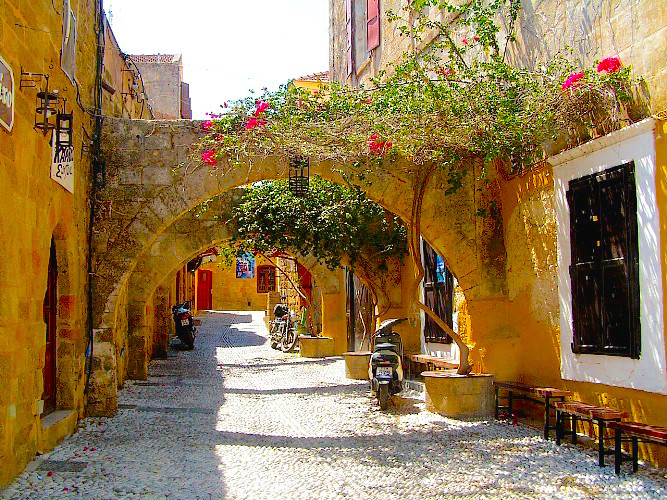 The Old City of Rhodes, which incidentally
is a World Heritage Site, is in my opinion after the
Acropolis of Athens and the Volcano of Santorini, the most
impressive place in Greece. To wander through the medieval
city, whether it is with crowds of tourists or in the off-season
when they are gone, is one of life's treasures and I can't
imagine someone visiting here and not wanting to return.
The old city is closed to automobile
traffic though the occasional motorbike
manages to get through and there are automobiles in some
areas, though the narrow streets and cobblestones make the going
slow and pedestrians are safe. The main streets and thoroughfares
are full of shops and restaurants but the back streets are
mostly residences, particularly in the Jewish Quarter where
life goes on as if nothing is going on a few blocks away
where giant cruise ships unload their passengers for a day
of shopping and sightseeing. The Old City of Rhodes, which incidentally
is a World Heritage Site, is in my opinion after the
Acropolis of Athens and the Volcano of Santorini, the most
impressive place in Greece. To wander through the medieval
city, whether it is with crowds of tourists or in the off-season
when they are gone, is one of life's treasures and I can't
imagine someone visiting here and not wanting to return.
The old city is closed to automobile
traffic though the occasional motorbike
manages to get through and there are automobiles in some
areas, though the narrow streets and cobblestones make the going
slow and pedestrians are safe. The main streets and thoroughfares
are full of shops and restaurants but the back streets are
mostly residences, particularly in the Jewish Quarter where
life goes on as if nothing is going on a few blocks away
where giant cruise ships unload their passengers for a day
of shopping and sightseeing.
|
|
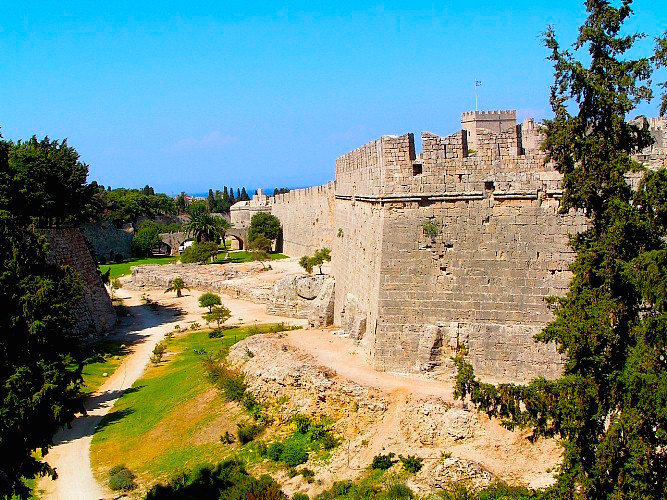 The walls of the city were a work
in progress for the 200 years the Knights ruled the island. Severely
damaged in the first siege they were rebuilt bigger and stronger
by Grande Master d'Aubusson after the siege of 1480. The walls are
12 meters thick and the moat more than 21 meters wide. The length
of the walls is about four kilometers and each section was defended
by one of the Langues or tongues which corresponded
to the languages spoken where the particular group of knights came
from. The Langues were England, Germany, France, Auvergne,
Provence, Italy, Castille-Aragon. The leader of each tongue
reported to the Grande Master. The entire area outside the walls
is a green park of shade trees and flowers and the moats now have
green grass and paths through them instead of water. A couple times a week there
is a tour of the city walls and fortifications. But leaving
through any of the gates and walking around the old city
will give you an idea of just how impressive and formidable
it was to the Turkish soldiers trying to take it. The walls of the city were a work
in progress for the 200 years the Knights ruled the island. Severely
damaged in the first siege they were rebuilt bigger and stronger
by Grande Master d'Aubusson after the siege of 1480. The walls are
12 meters thick and the moat more than 21 meters wide. The length
of the walls is about four kilometers and each section was defended
by one of the Langues or tongues which corresponded
to the languages spoken where the particular group of knights came
from. The Langues were England, Germany, France, Auvergne,
Provence, Italy, Castille-Aragon. The leader of each tongue
reported to the Grande Master. The entire area outside the walls
is a green park of shade trees and flowers and the moats now have
green grass and paths through them instead of water. A couple times a week there
is a tour of the city walls and fortifications. But leaving
through any of the gates and walking around the old city
will give you an idea of just how impressive and formidable
it was to the Turkish soldiers trying to take it.
|
|
There are two ways to approach exploring
the old city. You can wander around aimlessly and stumble upon its
treasures and figure out what you saw later or you can invest in
a map. Having done the first I recommend the second. Much of
the stuff I saw I had to figure out what it was by finding it on
a map and reading about it long after I had left the island. There
are a couple hotels in the old city though
getting a taxi to take you to the door is difficult because
of the narrow streets. There are a number of good
restaurants and more than enough fast-food places.
|
|
The Colossus of Rhodes
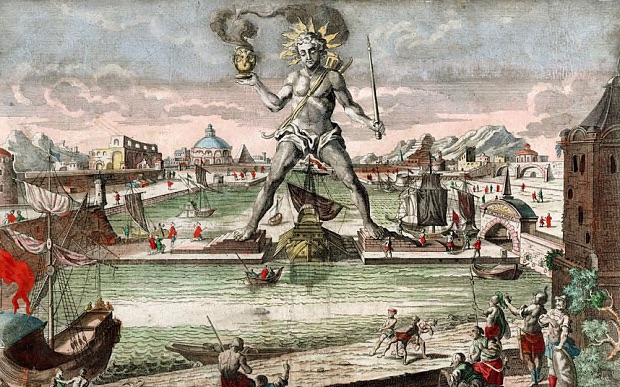 One of the 7 wonders of the world, the bronze statue built by Chares of Lindos called the Colossus to commemorate the Rhodian triumph after the siege of Dimitrious the Besieger in 305, using the money they made by selling the siege equipment he left behind to pay for the material and labor which took 12 years to complete.
Though the most popular image of the 31 meter tall statue is straddled across the entrance of the harbor with the ships passing
beneath it, it is more
probable that it stood on dry land somewhere close to where the Grande Master Palace is now. Regardless of where it stood, it did not stand there long because 66 years after it was built it fell in the earthquake of 266 BC. Fearing it was cursed they never rebuilt it but the statue lay where it fell for eight centuries. When the Arabs captured Rhodes in 653 AD they sold it to a Jewish merchant who they say needed 900 camels to take it away. But for those of us who missed it there are plans to rebuild it
so stay tuned. One of the 7 wonders of the world, the bronze statue built by Chares of Lindos called the Colossus to commemorate the Rhodian triumph after the siege of Dimitrious the Besieger in 305, using the money they made by selling the siege equipment he left behind to pay for the material and labor which took 12 years to complete.
Though the most popular image of the 31 meter tall statue is straddled across the entrance of the harbor with the ships passing
beneath it, it is more
probable that it stood on dry land somewhere close to where the Grande Master Palace is now. Regardless of where it stood, it did not stand there long because 66 years after it was built it fell in the earthquake of 266 BC. Fearing it was cursed they never rebuilt it but the statue lay where it fell for eight centuries. When the Arabs captured Rhodes in 653 AD they sold it to a Jewish merchant who they say needed 900 camels to take it away. But for those of us who missed it there are plans to rebuild it
so stay tuned.
|
|

 One of the 7 wonders of the world, the bronze statue built by Chares of Lindos called the Colossus to commemorate the Rhodian triumph after the siege of Dimitrious the Besieger in 305, using the money they made by selling the siege equipment he left behind to pay for the material and labor which took 12 years to complete.
Though the most popular image of the 31 meter tall statue is straddled across the entrance of the harbor with the ships passing
beneath it, it is more
probable that it stood on dry land somewhere close to where the Grande Master Palace is now. Regardless of where it stood, it did not stand there long because 66 years after it was built it fell in the earthquake of 266 BC. Fearing it was cursed they never rebuilt it but the statue lay where it fell for eight centuries. When the Arabs captured Rhodes in 653 AD they sold it to a Jewish merchant who they say needed 900 camels to take it away. But for those of us who missed it there are plans to rebuild it
so stay tuned.
One of the 7 wonders of the world, the bronze statue built by Chares of Lindos called the Colossus to commemorate the Rhodian triumph after the siege of Dimitrious the Besieger in 305, using the money they made by selling the siege equipment he left behind to pay for the material and labor which took 12 years to complete.
Though the most popular image of the 31 meter tall statue is straddled across the entrance of the harbor with the ships passing
beneath it, it is more
probable that it stood on dry land somewhere close to where the Grande Master Palace is now. Regardless of where it stood, it did not stand there long because 66 years after it was built it fell in the earthquake of 266 BC. Fearing it was cursed they never rebuilt it but the statue lay where it fell for eight centuries. When the Arabs captured Rhodes in 653 AD they sold it to a Jewish merchant who they say needed 900 camels to take it away. But for those of us who missed it there are plans to rebuild it
so stay tuned.